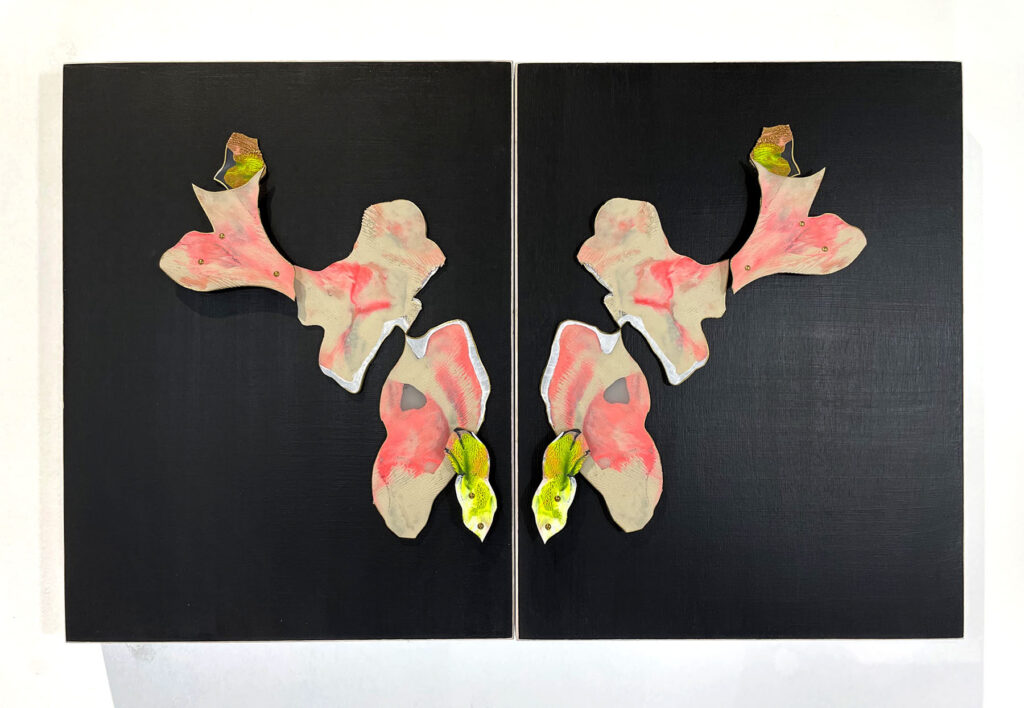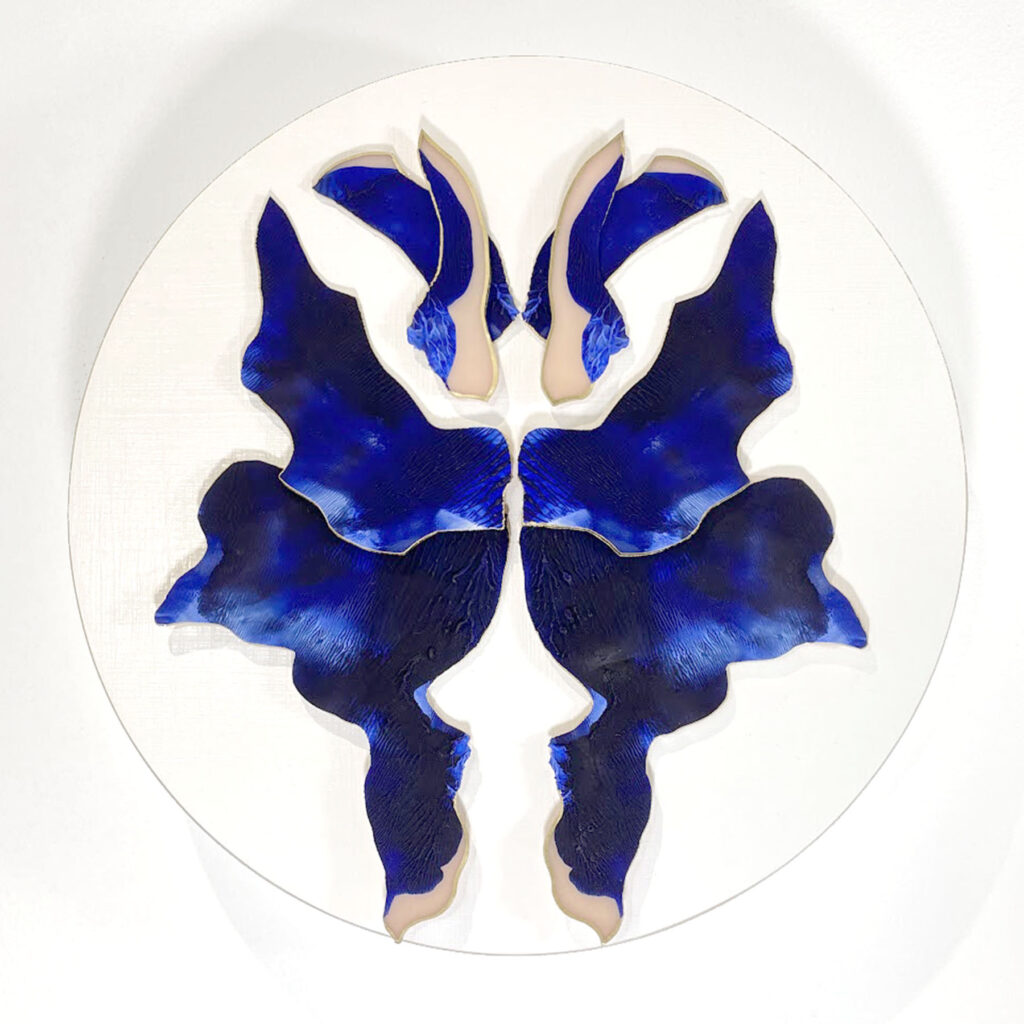Can You See the Difference Between Rorschach and Gobolink? Natale Adgnot’s Show Puts You to the Test

Before Hermann Rorschach began to use klecksography, inkblot drawings, to determine psychological health in his patients the act of creating shadow pictures—and eccentric shapes—by dropping ink on paper was an amusement. In fact, Gobolinks, short for “goblins of ink,” was a 19th-century parlor game. In her new solo show, artist Natale Adgnot who has a strong fascination for science, psychology as well as patterns, explores the trope of inkblot drawings, aimed at both testing and pleasure. The exhibition presents a series of three-dimensional thermoplastic wall sculptures that attempts to renegotiate the boundaries of our perception of the inkblot. The exhibition is up through January 4th at Established Gallery in Brooklyn.
I met with Adgnot to learn more about her artistic process, what the relationship between a Gobolink and the Rorschach test is, and how her work tests the premise of pareidolia—defined as seeing patterns in random information.

Natale Adgnot
“Through abstract drawing and sculpture, I explore the connection between logic and error. Lured by the beauty of pattern and the promise of explanation, we fall prey to cognitive biases and other fallacies. GOBOLINKS is a further extension of my fascination with cognitive bias, and understanding the tricks that our eyes play on us”
Alexandra Israel: During our gallery visit, you mentioned that Gobolinks were at one point a Victorian parlor game. This was totally fascinating news to me–spoiler alert, Gobolinks was the predecessor of the Rorschach Test! How did you learn about Gobolinks? And how did Gobolinks become an inspiration for this series?
Natale Adgnot: It’s true that Hermann Rorschach ended up cornering the pop-culture market on symmetrical inkblots!
All of my work deals with cognitive bias – how it colors our perception of everything, even while we believe we’re seeing the world around us objectively. I have been working on a sketchbook for eight years now that specifically taps into pareidolia, which is the same cognitive bias that Rorschach tests measure. So really, it was only a matter of time before I was going to borrow the trope of the Rorschach test.
But klecksographs (the technical term for symmetrical splotches) had already been a thing for a while before Rorschach turned them into psychological tests. It was during my research on Rorschach that I came across these “goblins of ink” called Gobolinks. In the late 1800s, a book called “Gobolinks or Shadow-Pictures” inspired a parlor game in which players would create inkblots, write rhymes about them on the fly, and then recite them to each other. Charming analog fun! The Gobolinks have a less judgmental connotation than the Rorschach tests without losing any of their power to inspire interpretation by the viewer.

Can you tell us more about your artistic process, and give us some behind the scenes details: what it was like to make this series?
All of my sculptural work can be traced back to two-dimensional work. The pieces in the Gobolinks series all literally began as two-dimensional works. I create the symmetry by adding acrylic paint to a large sheet of thermoplastic and then folding it in half to apply it to both sides. These large sheets are then cut into smaller pieces by hand – think kindergarten snowflakes made from printer paper.
The crazy textures happen when I shrink the plastic pieces and the paint wrinkles up. Those textures are a huge part of why I wanted to make this series. We’re so used to seeing symmetrical inkblots in shades of gray and black, but without any texture or dimensionality. I wanted to see how those added elements would affect people’s interpretations of the compositions.

Your work is also a commentary on cognitive bias, the disconnect between what we think we are seeing vs what we are actually seeing and the powerful influence of social psychology. Did the Gobolinks series come out as you had expected?
The fun thing about klecksographs is that there is no objective answer to the question, “what am I looking at?” In a similar way, I didn’t have any specific answer to the question, “what should these look like?” aside from making them symmetrical, textured, colorful sculptures. Since so much of my work is very research-heavy, this series has been mercifully process-driven and playful.

The Gobolinks series has a lot of hidden layers, and you’ve woven in different cultural references. I still can’t get over how little I know about the Rorschach test except for how commonly it’s brought up in books and movies! What were you hoping that the main takeaway would be for viewers?
As with all of my series – as different as they look from one another – I’m hoping to remind the viewer of their human subjectivity and fallibility. I’m reminded of my own as I create the work.

You had mentioned that this work is parallel to the plane, and the majority of your work is focused on perpendicular work. Can you elaborate on that?
Most of my sculptural work entails adhering the lightweight thermoplastic details on their edges to the birch panels. That’s because, when I initially began using this material, the objective was to raise the black and white line drawings from my sketchbook up from the surface of the panel. That first (and ongoing) series called Drawings in Three Dimensions, aims to drive home the point that things can look very different when viewed from different angles.
The Gobolinks sculptures are a departure from that idea, structurally speaking, but are just as much an exploration of cognitive bias.
I loved learning that you’ve kept all of your sketchbooks, and you often go back to your sketchbook for inspiration. Can you discuss a little more the pieces in this show that were inspired by sketchbook work?
Most of the wall sculptures from my earlier series are based on drawings from my sketchbook. In this show, I’ve also included a few monoprints that are literally mirrored transfers of sketchbook drawings.
To learn more about Natale Adgnot’s work, please visit her website or Instagram.
You Might Also Like
Can Artists Succeed Without Gallery Representation? CJ Hendry Says Yes
Méïr Srebriansky Tests Boundaries in His Solo Show “Age of Resin”
What's Your Reaction?
Alexandra Israel graduated from Bates College in 2010. A museum aficionado since her introduction to Jean Dominque Ingres' portraits as a small child, she enjoys spending her free time at museums and finding off-the-beaten-track gallery shows. Israel has been working in PR for over seven years, primarily within book publishing and in the art world. She has held positions at Penguin Book Group, Aperture Foundation, and Third Eye among others. l Instagram l

